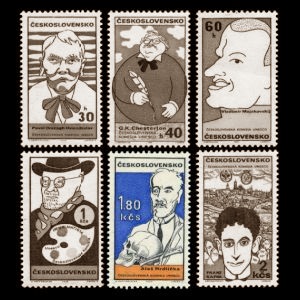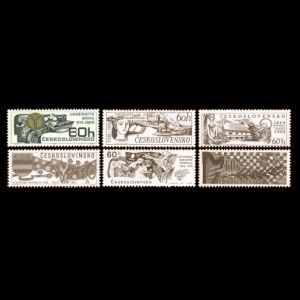the place where Paleontology and Paleoanthropology meets Philately
Czechoslovakia
Fossils, prehistoric animals, anthropologist, Charles Darwin on stamps and postmarks of Czechoslovakia
| << previous country | back to index | next country >> |
Contents:
- Country overview
- Philately of Czechoslovakia
- Official stamps of Czechoslovakia related to Paleontology and Paleoanthropology
- Other stamps of Czechoslovakia to consider
- Commemorative postmarks of Czechoslovakia related to Paleontology
- References
- Acknowledgements
Czechoslovakia was a sovereign state in Central Europe that existed from October 1918, when it declared its independence from the Austro-Hungarian Empire, until its peaceful dissolution into the Czech Republic and Slovakia on 1 January 1993. From 1939 to 1945, following its forced division and partial incorporation into Nazi Germany, the state did not de facto exist but its government-in-exile continued to operate. From 1948 to 1990 Czechoslovakia was part of the Marxist–Leninist Warsaw Pact, which was formed in May 1955, and had a command or planned economy. A period of political liberalization in 1968, known as the Prague Spring, was forcibly ended when several other Warsaw Pact countries invaded. In 1989, as Marxist–Leninist governments and communism were ending all over Europe, Czechoslovaks peacefully deposed their government in the Velvet Revolution; state price controls were removed after a period of preparation. In 1993 Czechoslovakia divided into two sovereign states, the Czech Republic and Slovakia. [R1]
The first stamps were issued in October 1918. After World War II, Czechoslovakia was re-established and regular issues of Czechoslovakia resumed. The last stamp of Czechoslovakia was issued on 18 December 1992 and marked Stamp Day. Although the Czech Republic and Slovakia officially separated on 1 January 1993, the stamps of Czechoslovakia continued to be valid for the payment of postage in both countries until the end of July 1993. [R2]
Official stamps of Czechoslovakia related to Paleontology: fossils, prehistoric animals, anthropologist, Charles Darwin
| 16.10.1959 "Famous persons" | 08.08.1968 "International Geological Congress" | 17.06.1969 "Famous persons" [1] |
 |
 |
 |
Notes:
[1] Anthropologist Ales Hrdlicka and human skull are on stamp with face value of 1,80 KCS.
"Hrdlička was interested in the origin of the human being. He was a critic of hominid evolution as well as the Asia hypothesis, as he claimed there was little evidence to go on for those theories. He dismissed finds such as the Ramapithecus which were labeled as hominids by most scientists, instead believing that they were nothing more than fossil apes, unrelated to human ancestry.
In a lecture on "The Origin of Man," delivered for the American Association for the Advancement of Science, at Cincinnati, Ohio, Hrdlička said that the cradle of man is not in Central Asia but in Central Europe, as Europe is the earliest known location where human skeletal remains have been found." [R3]
Other stamps to consider
| 24.03.1969 "Scientific and Cultural Institutions" [A1] | 18.2.1991 "Personalities" [A2] | |
 |
 |
|
Notes:

[A1] One of the stamps from "Scientific and Cultural Institutions" that celebrates the 50th anniversary of the University of Brno shows ammonite at the bottom left corner. The ammonite of Clambites hypselus species from the Jurassic period. This is a small species with size of 10cm - 15cm about.
[A2] One of the stamps (the first on the image above) shows Andrej Kmeť.

|
|
Andrej Kmet on stamp of Czechoslovakia 1991, MiNr.: 3080, Scott: 2821 |
Commemorative postmarks of Czechoslovakia related to Paleontology: trilobites
Legend is here| 08.08.1968 "International Geological Congress" [FDC] | 03.10.1983 "100 years since death of Joachim Barrande" [Sp] | |
 |
 |
|
References:
- [R1] Czechoslovakia: Wikipedia,
- [R2] Postal History and Philately of Czechoslovakia: Wikipedia.
- [R3] Ales Hrdlicka: Wikipedia
- [R4] Andrej Kmeť: Wikipedia
Acknowledgements:
Many thanks to Dr. Peter Voice from Department of Geological and Environmental Sciences, Western Michigan University, for reviewing the draft page and his very valuable comments.
| << previous country | back to index | next country >> |